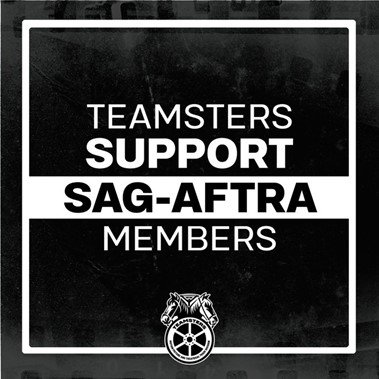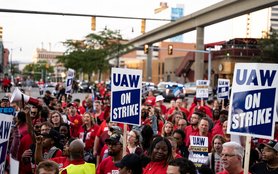Writers. Actors. Hotel workers. And soon, most likely, Teamsters. It’s the summer of strikes, when hundreds of thousands of unionized workers are flexing their muscle of collective action. Why is this erupting with flash and heat in such a brutal summer?
Despite the relentlessly beating sun, record numbers of workers are walking off the job and picketing in the streets this summer. Last year, the number of workers on strike increased by nearly 50% (from 80,700 in 2021 to 120,600 in 2022); the number will likely skyrocket this year, especially if 340,000 Teamsters go on strike at the end of July when their contract expires.
Why is 2023 the year of strikes in the U.S. (and, in reality, around the world)?
It didn’t happen overnight; for decades, the landscape in the economy has been shifting, taking power away from working people and putting it in the hands of corporations and the ultrawealthy. Working families are reaching the tipping point, ready to make some sacrifices to stand up to corporations that have worked long and hard to rig the game in their favor.
A few factors at play.
1. Compensation is wildly lopsided.
Without a doubt, workers are seeing declines in the real value of wages. Inflation has eaten away at working families’ ability to stay afloat (especially on basic goods, resulting from the war in Ukraine, the pandemic, and corporate opportunism (greedflation) to raise prices). And while it’s cooled recently, that doesn’t necessarily mean prices are coming down.
But this isn’t just about recent shocks to the economic system. It’s about a steady trend in the economy over decades where the rewards of our economic powerhouse and worker productivity are going to the TOP of the chain.
As the Economic Policy Institute notes, “From 1979 to 2020, net productivity rose 61.8%, while the hourly pay of typical workers grew far slower—increasing only 17.5%.”
During these same decades, executive compensation and corporate profits soared. The ratio between compensation for CEOs vs average workers has gone haywire; in 1965, it stood at 20-to-1, by 2021, it had reached 399-to-1 (and it is much higher in certain sectors that feature low-wage jobs, such as fast food and retail). During the pandemic, CEO compensation skyrocketed, jumping 30% between 2019 and 2021, while worker compensation increased by 3.9%.
Last year, corporate profits achieved the widest margins in 70 years.
As Fran Drescher noted in a press conference on the strikes in Hollywood: “Employers make Wall Street and greed their priority and they forget about the essential contributors that make the machine run… I am shocked by the way the people that we have been in business with are treating us… How they plead poverty, that they’re losing money left and right when giving hundreds of millions of dollars to their CEOs.”
And Teamsters president Sean O’Brien responded on Twitter: “As @frandrescher stated earlier this afternoon, what’s happening to actors in this country is happening across all areas of labor. Employers have chosen greed as the priority instead of rewarding & protecting essential contributors who make the machine run.”
Indeed, the economy has lost the common goal of shared prosperity. Corporations are now dedicated to generating prosperity for executives and shareholders, and to squeezing workers for all the money they can get out of them.

2. Working conditions are deteriorating.
If it feels like going to work has become more dangerous to people’s health and well-being–that’s because it has. And employers rarely do enough to protect people on the job.
The Teamsters specifically bargained to ensure that drivers are guaranteed cooling gear and enhanced training in extreme heat, given that temperatures in trucks that lack air conditioning can reach 150 degrees F.
Changes in the climate are threatening the lives of both outdoor and indoor workers. Shocking heat waves endanger farmworkers, construction workers, and more; extreme weather events cause flooding and winds that endanger workers in rescue and reconstruction operations; heat exacerbates the dangers of insects and pesticides; and wildfires create respiratory hazards.
COVID-19 took a terrible toll on people in “essential,” often low-wage jobs: health care workers, meat and poultry processing workers, food preparation and service workers, warehouse workers, transportation workers. While these people enjoyed a moment in the spotlight during the worst of the pandemic, they are largely back in the shadows again, and still enduring low wages in hazardous conditions.
3. Corporations and the ultrawealthy have changed our legislatures and rigged the game in their favor.
Corporate power now plays a vastly outsized role in determining public policy—especially as it relates to labor policies. Many U.S. labor policies fly in the face of public opinion, but they stand because Members of Congress are more interested in pleasing deep-pocket donors than ordinary voters.
But it wasn’t always this way. Starting in the 1970s, companies realized the benefit of investing in lobbying as a way to pressure Congress. In 2022, money spent on corporate lobbying ballooned to $3.5 billion per year.
Business now accounts for 87% of all lobbying dollars. Of the 100 organizations that spend the most on lobbying, 95 consistently represent business. Every year, companies and business groups spend millions on efforts to discourage increases in the federal minimum wage, as well as the tipped wage. Among the organizations: the National Restaurant Association, American Legislative Exchange Council (ALEC), the U.S. Chamber of Commerce and the National Right to Work Committee.
The business lobby has been a major force in preventing support for the PRO Act (which would restore some lost power to workers and their ability to organize), and raises to the minimum, subminimum, and tipped wages; at the state level, it is behind so-called “right-to-work” laws, which weaken unions.
Just this June, the Supreme Court ruled an employer could sue a union for damages if it believes activism has hurt the business.
4. Technology is reducing workers to robots.
While writers and actors are raising the alarm about the possibility of exploitation from new AI technology, the reality is that automation has been enabling employers to exert disturbing levels of control over people in the workplace for decades. And recently it’s gotten so extreme that it extends into every aspect of life on the job.
From the cotton gin to the assembly line in industrial factories to “just-in-time” scheduling to “time off task” technology and surveillance, the end result is “algorithmic management” that removes all humanity from the workplace.
Millions of workers report that they feel like robots, parts of huge machines, with a constant rhythm to do more, faster, no matter the stress to mind or body; and at the whim of machines that schedule them to show up at any time, often with no assurance of full shifts.
5. Corporations are growing bigger and more powerful.
No wonder workers increasingly feel the need to work together to counter the excesses of corporate employers; corporations are growing more mammoth and more ruthless.
For decades, businesses have been merging, acquiring, and consolidating power over the market, including the labor market. The pandemic threw fuel on the fire, as large companies grew rapidly and small businesses failed.
Some of these companies are enormous; the top five are bigger than the next five by the largest margin since the early 1980s. They employ huge numbers of people, which gives them inordinate power to control and exploit the workforce.
In a recent Twitter thread, Lina Khan, Chair of the Federal Trade Commission, noted that consolidation and vertical integration have “enabled the business practices now prompting workers to strike.” Mergers result in fewer employer options, depresses pay, and block access to key data about viewership.
As Austan Goolsbee notes in the New York Times, “Corporate concentration has grown significantly in recent years, bringing with it increased corporate profits and a falling share of income going to workers.”
Moreover, large companies have very deep pockets for opposing attempts to unionize. Corporations spend at least $400 million per year on “union-avoidance” consultants--but that’s the tip of the iceberg.
6. The labor market is tight.
As the economy has bounced back from the pandemic, it has put people back to work: the unemployment rate is down to 3.6%, with employers scrambling to fill jobs.
A tight labor market enables workers to find better jobs; but it also emboldens workers (especially union members) to fight for better wages and conditions.
7. The workforce is growing younger—and more engaged and ready to act.
As the workforce grows younger (and does so quickly, as normal aging trends were exacerbated by early departures due to COVID-19), the general sentiment toward unions and strikes grows more positive.
While a Gallup poll last year put Americans’ approval of labor unions at more than 70%, it’s highest among younger people. Indeed, much of the new unionizing activity is from younger workers, often stuck in low-wage jobs and carrying onerous student debt.
__________________________________________________
It all adds up, as working people increasingly grasp the value of uniting with each other, finding power in the collective, and striking to stop the machine from running. It’s about empowering people to stand up and start to reset the balance of power.
As the Teamsters Twitter account notes: “Working people are tired of being beaten down, underpaid, and taken advantage of by Corporate America.”
For more information on why and how workers strike, please visit the EPI excellent primer on the history and significance of strikes in the U.S.



